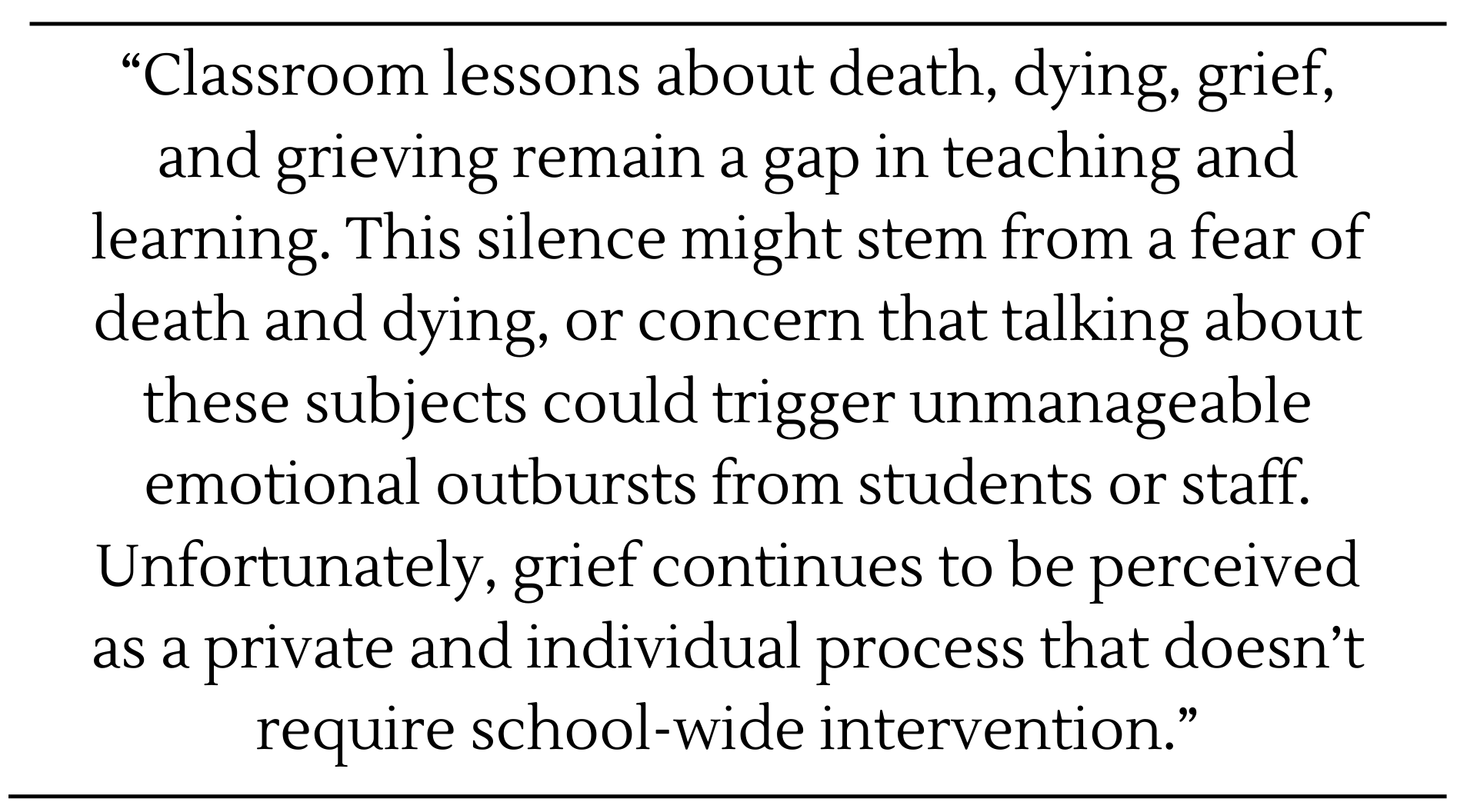Teaching and Learning While Grieving: Lifting the curtain on grief to better support educators and students experiencing loss
Grief continues to be perceived as a private and individual process that doesn’t require school-wide intervention.
Building strong relationships with students is a necessary part of being a good teacher, yet having the strength to be vulnerable and authentic in these teacher-student relationships often requires that educators repress their true emotions — like anger, fatigue, or frustration — in favour of more “workplace appropriate” emotions. When we think about an emotion as complex as grief, which is rarely discussed in schools, it can be easy to understand why it can be so burdening for teachers to constantly keep a smile on while masking how they truly feel.

Nine months ago, my mother was diagnosed with cancer. Because she was generally healthy and active, I was naively convinced that she would live to see her 100th birthday. Even as my mother’s health deteriorated and my family duties piled up, I continued teaching at universities and middle schools all while continuing forth presenting my research on ‘emotional labor’ at various conferences.
I thought I had been doing just fine at handling all of the stress — whether that be from accompanying my mom to radiation treatment appointments and emergency trips to the hospital, or the overall experience of witnessing my mom gradually lose her independence. Then, one day, while teaching a lesson on poetry during one of my summer school classes, my eyes had unexpectedly filled with tears as I presented a metaphor from the song “The Bridge” by Chris de Burgh.

To my horror, I had broken a “workplace appropriate” rule as I silently wept while the song played. Fortunately, the song was over four minutes long, and I could use my long hair to shield my face while I tried to wipe away my tears without anyone noticing. By the time the song had ended, I was able to compose myself and make a silly joke about sad love songs while carrying forward with my discussion on poetry.
My students were clearly uncomfortable during what must have been an awkward moment seeing their teacher cry. They ignored my outburst, kept their heads down, and carried on jotting down notes. I had told them earlier in the week about my mother’s cancer, yet the incident was never discussed and we continued with the lesson like nothing had happened.
Why there’s an emotional silence around grief in the classroom
‘Grief’ is described in the 2012 Encyclopedia of Human Behavior as the emotional response to bereavement — the loss of a significant person. The process of grieving is often described as a series of stages — denial, anger, bargaining, depression, and acceptance — as first defined by Dr. Elisabeth Kubler-Ross in 1969. More recently, grief has been described as being a more complex and nuanced response to loss, rather than merely moving through a series of stages.

The experience of grief can result in many physical and psychological symptoms including sleep deprivation, appetite changes, changes in energy levels, physical pain or discomfort, using prescription or other drugs, and increased risk of illness. While most grieving people experience these to varying degrees, symptoms will ease over time. Nevertheless, depending on the suddenness or severity of the loss, these symptoms can last for weeks, months, or years.
Grief is a taboo subject in western schools that’s rarely discussed openly between educators and students. Grieving is very common in childhood, where it’s been estimated that before the age of sixteen, 1 in 20 students in the United States will experience the loss of a parent.

Discussion on how to help students who are grieving is currently not a priority in pre-service teacher education programs or within school curricula. Classroom lessons about death, dying, grief, and grieving remain a gap in teaching and learning. This silence might stem from a fear of death and dying, or concern that talking about these subjects could trigger unmanageable emotional outbursts from students or staff. Unfortunately, grief continues to be perceived as a private and individual process that doesn’t require school-wide intervention.
How to work towards unsilencing grief in the classroom
There are key ways to surface discussions on supporting children, youth, and adults with the common human experience of grief.
Support for students
Given the probability that one or more students in every classroom is experiencing grief, educators should become more aware of the psychological and physical symptoms that are associated with it. Grieving children and youth can display a variety of behaviours including inattention, self-blame, clinginess to parents or staff, and overreaction or underreaction to emotional triggers, the latter of which could be misdiagnosed as learning problems. Staff in schools should be made aware of a student who has had a significant loss in their life so that they can be better prepared to assist and support them appropriately. Resources such as After a Loved One Dies by the New York Foundation provide caregivers with suggestions on how to support children who are experiencing the loss of someone who has passed away.
Additionally, educators should be aware that this loss of a friend or loved one can have a devastating impact on the student’s home life.

The student is likely surrounded by grieving adults who may be unable to fully support them. Daily mundane tasks, such as getting ready for school, catching the school bus on time, completing homework assignments, and making healthy lunches, can fall by the wayside due to this disruption in the student’s primary care network. Furthermore, the child or youth may not be getting the emotional support that they need and may be afraid to upset the adults around them by speaking of their own distress.

Support for colleagues
As I’ve gone about presenting my research on emotional labor, I’ve heard one dominant comment from educators: “There’s no crying in teaching!” As class sizes become larger and time is spread thinner for teachers, school leaders, educational assistants, and psychologists across more and more students, even less time is available during the school day for grieving adults to express their emotions in their everyday work.
Most adults describe grief as something that they eventually come to tolerate, but they nonetheless carry the memory of their loss with them in their daily work. For educators who have experienced loss, often the unspoken rule is that they should just “get on with it” once the immediate crisis of death has passed. Grieving educators are not given the time, space, or relational support that they need during their workday to be the caring, calm adults that students need in the classroom.
Instead of seeking the end of grief, supportive adults can help fellow colleagues work through it by understanding and adjusting to their expression of the physical and psychological symptoms of grief. Most adults have different ways of expressing their emotions and may do so through physical exercise, writing, speaking, or singing loudly in their car. Rather than moving straight to the common advice of “You need to talk to someone!”, ask “What do you need right now to release how you’re feeling?” or “Do you have the time, space, or relational support that you need to deal with your grief?”

The months-long process of witnessing my mother’s life drain away has opened my eyes to the need for educators to both give and be given space to have conversations about grief in schools. Even as a 47-year old woman, I have felt unprepared to cope with the heavy sadness and broken heart generated by losing my mother, even as I feel gratitude for her long life and legacy of love and support. Schools are a community of support for children, youth, and adults who have lost a significant person in their life. As such, educators have a responsibility to lift the curtain on grief and grieving in the classroom.
References and Additional Information
Kennedy, C., Keeffe, M., Gardner, F., & Farrelly, C. (2017). Making death, compassion and partnership ‘part of life’ in school communities. Pastoral Care in Education, 35(2), 111-123.
Hochschild, A. (2012). The managed heart commercialization of human feeling. Berkeley: University of California Press.
Kendrick, Astrid Helene. (2018). Inspiring Change: A Hermeneutic Phenomenology Exploring the Lived Experience with Emotional Labor by Female Health Champions Implementing Comprehensive School Health Reforms. Werklund School of Education.
Kendrick, A. (2018). Let go of toxic workplace ’emotional labour’ in 2019. The Canadian Press, p. The Canadian Press, Dec 20, 2018.
Kennedy, C., Keeffe, M., Gardner, F., & Farrelly, C. (2017). Making death, compassion and partnership ‘part of life’ in school communities. Pastoral Care in Education, 35(2), 111-123.
Schonfeld D.J. & Demaria T. (2016) Supporting the Grieving Child and Family. Pediatrics 138(3). AAP committee on psychosocial aspects of child and family health, disaster preparedness advisory council.
Strobe, M. & Strobe, W. (2012). Grief and Bereavement. Encyclopedia of Human Behavior. Retrieved from https://www.elsevier.com/books/encyclopedia-of-human-behavior/ramachandran/978-0-12-375000-6
Photo: Adobe Stock
